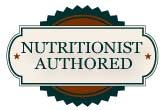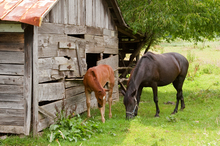
Magnesium. You hear about it a lot these days, particularly when it comes to treating obese horses, especially those with the telltale sign of insulin resistance: stubborn fat deposits along the crest of the neck and back, and behind the shoulders.
And since magnesium is also involved with maintaining normal neuromuscular activity, supplementing it can have a dramatic impact on calming behavior, easing sensitivity, and improving muscle function and endurance.
How much magnesium for your horse?
The insulin resistant animal responds well to large amounts of supplemental magnesiumi. However, magnesium needs to be balanced with calcium because calcium competes with it for absorption; therefore the magnesium content should be at least half that of calcium.

Importance of nutritional balance in horses
Since magnesium is involved with maintaining normal neuromuscular activity, supplementing it can have a dramatic impact on behavior, improved muscle function and endurance.
Forages grown in areas of acidic or clay soils are typically low in magnesium. Compound this with low bioavailability, and your equine friend may be getting just enough to prevent a deficiency but not quite enough to maintain normal hormonal and nervous system functioning.
To help with regional fat deposits, I recommend supplementing magnesium to bring it in line with calcium. A 2:1 ratio of Ca:Mg is appropriate and can be as high as 1:1.
Consider this example: Your hay contains .25% magnesium and .60% calcium. Twenty pounds provides 22.7 grams of magnesium (20 lb X 454 g/lb X .0025) and 54.5 grams of calcium (20 lbs X 454 g/lb X .0060). Assume that only 50% of the magnesium from your hay is absorbed; therefore, only 11.35 grams of magnesium is provided by this hay.
Supplement additional magnesium to bring the Ca:Mg ratio to 2:1ii. So in this example, you should supplement an additional 16 grams of magnesium to bring the Ca:Mg ratio into balance.
Obviously it is best to test your hay before supplementing magnesium. If this is not feasible, offer your 1000 lb horse a more conservative amount -- say 10 grams per day. Continue supplementing until you see the fat pads start to diminish (can take several months); then reduce the amount of magnesium by half.
To help with behavior or muscular issues, experiment by adding 3 to 10 grams of magnesium to the diet. Results should be seen within a week; if not, magnesium is not the issue.
Inorganic sources and absorption
Magnesium found in forages and feedstuffs is not well absorbed – only 40 to 60 percent. This has a lot to do with competition from calcium.
Consequently, inorganic sources such as magnesium oxide, citrate, and sulfate have a higher absorption rate (70%) than magnesium found in natural sourcesiii. Comparisons between three inorganic sources are shown below:
|
Commonly Supplemented Inorganic Magnesium Sources and Concentrations |
|||
|
Source |
Percent Mg |
Amount needed to provide |
Comments |
|
Magnesium oxide |
56.2% |
8.9 g |
Readily absorbed and most concentrated. |
|
Magnesium citrate |
11.0% |
45.5 g |
Most easily absorbed but low concentration, necessitating larger amounts. |
|
Magnesium sulfate |
9.8% |
51.0 g |
Epsom salt. Poorly absorbed and has a high laxative effect. |
Whole foods
The magnesium found in natural sources is chelated (bound) to another molecule, such as an amino acid, to facilitate absorption. While the absorption rate is slightly diminished by calcium, whole foods boost your horse’s overall diet by adding additional minerals, as well as vitamins, fats, and protein.
Whole food sources of magnesium are not nearly as concentrated as a magnesium supplement. But they can aid in reducing insulin resistance as well as protect your horse’s nervous system and muscles. These foods are especially high in magnesium, and are listed from high to low levels (found in one cup):
- Pumpkin sides (shelled): 1200 mg
- Flax or Chia seeds: 660 mg (high in omega 3s)
- Sesame seeds: 500 mg
- Almonds: 400 mg
- Quinoa: 340 mg (high in starch)
- Wheat germ: 275 mg (high in omega 6s)
- Split peas: 230 mg
Can you give a horse too much magnesium?
Not likely. According to the National Research Councilv, the maximum tolerable concentration is 0.8 percent. Twenty pounds of hay testing at this level would provide a whopping 72.64 grams (72,640 mg) of magnesium.
The gastrointestinal tract only absorbs what the body needs and the rest is excreted in the manure. However, since the kidneys are responsible for excreting magnesium, supplements should never be given to a horse with impaired kidney function; this would result in high blood magnesium levels, leading to neuromuscular symptoms such as depressed behavior and ataxia.
Bottom line
Many horses experience a borderline deficiency of magnesium because of its poor absorption rate from forages. Regional fat deposits, indicative of insulin resistance, can be reduced through magnesium supplementation (in combination with low starch/sugar diets and exercise), offering some protection against laminitis. Neuromuscular and behavioral sensitivities can also be alleviated with added magnesium.
About Dr. Juliet M. Getty
Juliet M. Getty, Ph.D. is an internationally respected equine nutritionist available for private consultations and speaking engagements. Dr. Getty is the Contributing Nutrition Editor for the Horse-Journal and she will be speaking at Equine Affaire in Massachusetts, November 7-10, 2013. Her comprehensive reference book, Feed Your Horse Like a Horse as well as books in her “Spotlight on Equine Nutrition Series” are offered for purchase through her website and at Amazon.com.
iDryden, DVM, Vern. 2013. Managing equine metabolic syndrome: Medicine meets farriery. Rood and Riddle Equine Hospital. Lexington, KY.
iiTo prevent enteroliths (intestinal stones), magnesium (as well as phosphorus) should never exceed calcium.
iiiHarrington, D.D., and J.J. Walsh. 1980. Equine magnesium supplements: evaluation of magnesium sulphate and magnesium carbonate in foals fed purified diets. Equine Veterinary Journal, 12, 32-33.
ivDivide amount of magnesium needed (in this case, 5 grams) by the percent magnesium in the source to get the amount of compound needed. Example, magnesium oxide (MgO) contains 56.2% magnesium. To obtain 5 grams of magnesium, divide 5 by .562 to get number of grams of MgO to measure.
vNational Research Council. 2007. Minerals. Nutrient Requirements of Horses, Sixth Revised Edition. Washington, D.C.: The National Academies Press. Pages 79-80.
